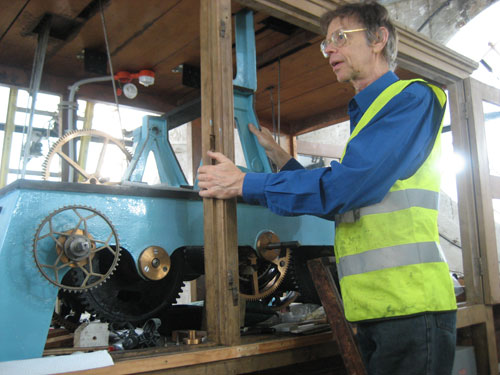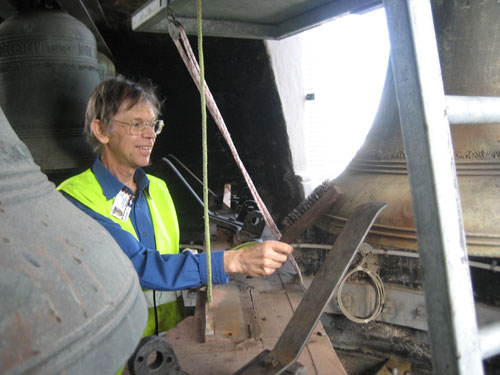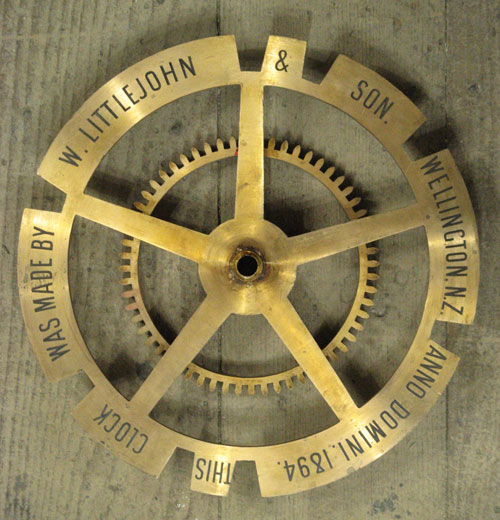Thursday 7 April 2011
Amy Cooper
High in the Gallery’s clock tower, horologist Michael Cryns has been spending the last several weeks fighting some formidable opponents. A slight, softly-spoken man, he’s battling the effects of the elements, and even time itself. It’s likely most people won’t ever see the results of his painstaking labour… but they’ll certainly hear it.
Last year this blog featured the story of how Michael came to work on the Gallery’s historic clock, and an update when a piece about him aired on TVNZ. This year, as we draw closer to reopening, he’s back on the scene to prepare the clock for its big moment.
I meet Michael at the Gallery and follow him on his daily commute: up five flights of stairs and a ladder to the clock tower’s middle level. Here the four faces of the clock surround the massive clock mechanism. Parts of the clock tower walls are covered in graffiti – I spy scrawls from the 1920s all the way through to this year. Another, even steeper ladder leads to the top level where the bells hang silent.

During the Gallery’s development the original clock mechanism has been turned off, with a motor Michael developed to keep the hands running in the meantime. “If the clock ever has a breakdown in the future we can just plug this back in,” he says.
Each of the four clock faces has its own set of gears. During the last four weeks, Michael’s taken out all the gears and bearings for cleaning and refurbishing. He uses kerosene and steel wool to clean the parts, being careful not to damage the surface, which still has its original lacquer.
“Cleaning is a massive job – so much grime accumulates over a hundred years. Although I overhauled it about 15 years ago, some is still there. But it’s very satisfying work, because you can see where you’ve been."
Looking at the array of gears, cogs and unidentifiable metal parts strewn around his work station, I have to wonder – does he ever pull a clock to pieces and then forget how to put it back together? “Yeah, that happens from time to time,” he chuckles. “I just puzzle it out. But once you’ve worked on a clock for a while, it becomes fixed in your memory how the bits go.”

Graffiti adorns the walls
The Gallery clock is one of only a few from the nineteenth century left in New Zealand – the Auckland town hall clock, which Michael also looks after, is another. So if he had to pick a favourite, which would he choose?
“This one, because it’s more original, more complicated and it does more – it has more chimes. It still has its original escapement (timing mechanism), while the Town Hall clock was changed to an electric one.”
In the next month or so Michael will be reinstalling the chimes, which play the well-known Westminster Quarters tune. We head up through the trapdoor to the top level to take a look at the bells. The huge hammers, which hit the bells to sound the chimes, have been dismantled and cleaned and are lying on newspaper on the floor, awaiting a fresh coat of paint. Since they’re out of action, Michael gives me a personal concert by whacking the bells with the handle of a brush.

The windows in the bell tower are open to the elements, so Michael’s adding louvres to stop the rain coming in and rusting all the mechanical parts. At the same time he’s been upgrading some of the clock’s peripheral features, including the electric night shut-off system. For years, the clock used to chime through the night. Now it’s been set to sound only between 8am and 8pm, so as not to upset city apartment-dwellers.
The clock mechanism is “about the size of a car, and probably weighs as much as one if not more”, according to Michael. When the mechanics are running, it can pose a danger. “The gears will take your hand off just like that,” he says. “When it’s running, you’d be surprised how fast the parts move.”
At least winding the clock is no longer part of Michael’s job description. The electric winding system – made of old bicycle parts - was installed in the 1950s, but before that it was hand-wound and would only run for about a week at a time. Michael says it would have been an exhausting and time-consuming job to wind it.
"It’s a funny world, isn’t it – people will happily spend time at the gym, but try to find somebody to wind a clock? Oh no.”

The countwheel of the clock, showing its manufacture. (Image: Michael Cryns)
Back down on the entrance level, the massive counterweights have been lowered almost to the ground. Jonno, one of the carpenters working on the gallery development, is helping create an earthquake-proofing system for the weights. It includes an impact platform that will help the weights survive a 6m drop, and they’ll be housed in a series of tubes to prevent them swinging and hitting things. Michael’s also installed new eyebolts to hold them up.
While repairing and maintaining clocks can be a very precise science, some aspects of the job are a little less meticulous. The mass of each of the three weights (about 200kg, 130kg and 70kg) was determined purely by trial and error. "You pile them on ‘til (the clock) goes, and if it goes too fast you take some off,” Michael grins.
It’s this kind of first-hand knowledge and experience that makes Michael a real asset to the Gallery – and to Auckland. And he’s keen to get future generations involved in the care of his beloved clocks.
"I would love an apprentice. I’m not sure how I’d go about it, but I would like to pass on my knowledge,” he says.
In the meantime, there’s still plenty of work for Michael to be going on with. Every 5-10 years he does a large-scale overhaul and makes a few peripheral upgrades at the same time. “The more I look, the more I find to do.”